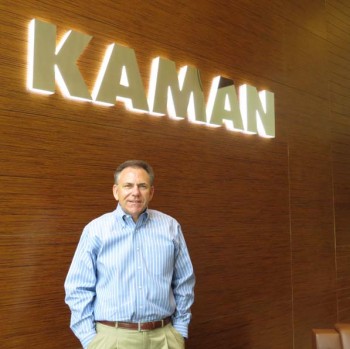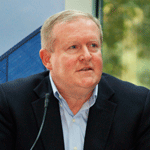
If you don’t change, you won’t survive. That’s the philosophy Greg Troy brought with him when he joined Kaman Corporation in 2012. Troy, who serves as the company’s senior vice president and chief human resources officer, came to the company to help make the company’s HR function as diversified and standout as the aerospace, manufacturing, and distribution company’s products and services.
In 1996, Kaman Corporation reached a milestone of $1 billion in sales. While it took about 50 years to get there, less than 20 years later the company is already halfway toward doubling it. With this comes a new challenge. “The skills that got Kaman to $1 billion in revenue won’t be same that get us to $2 billion,” Troy says.
Composed of Kaman Aerospace and Kaman Distribution, Kaman Corporation has a global presence comprised of more than 230 distribution sites, 13 manufacturing and operating aerospace locations, and 5,000 employees. When Troy assumed the responsibility of leading Kaman’s people strategy in 2012, he faced a business ready to hit its next milestone but hindered by an HR configuration lacking standardization. In Kaman Aerospace alone, five different HR policies existed that fragmented the business. The root of the problem: inconsistency.
Historically, Kaman had grown both organically and through widely spaced acquisitions, and was able to function without a corporate HR policy for half a century. Shifting gears in 2007, with the start of a 14-acquisition growth spurt, it became obvious that a diversified HR function was not conducive to the overall company’s efficiency. “I believe in standardization when possible, but I don’t believe in centralization,” Troy says.
The State of HR
A Discussion with Greg Troy
What trend is driving your HR philosophy?
Sequestration. We can’t forget that our aerospace suppliers are being affected by reduction of the federal budget. It’s forcing us to be creative when looking at commercial and military defense customers, and strategic in our workforce planning to apply the right amount of overhead.
Define your current talent strategy.
We’re implementing a training curriculum for all levels of the company starting with on-boarding, then a basic management school, then our own Kaman Leadership Development Program, and finally executive development mentoring. The objective for all training is to develop employee skills and spur career growth to drive the success of the business as a whole.
What is the best way to show you value an employee?
Show passion in what you love to do. I think I was destined to do this work. I want to be the human capital driver that makes a difference.
During his first year in Kaman’s Bloomfield, Connecticut headquarters, Troy spent the bulk of his time “threading” the HR function. To do this, he developed a policy he illustrates by likening it to the structure of a house. The people, Kaman’s talent, are the foundation. Five “pillars” support the goal of employee excellence: recruiting and hiring, performance management, succession planning, total rewards, and learning management. Within the pillars, different initiatives demonstrate leadership’s commitment to the base, and consistency across the corporation inspires trust.
Central to the succession-planning pillar is the Kaman Leadership Development Program. Through the program, Kaman employees have the opportunity to train with senior management, preparing them to continue to uphold the standards that the Kaman senior team have set.
Troy admits the changes made to the function were not seamless and that some employees required more assistance in the transition than others, but the support of his CEO was never in question. “He and I connect on employee values,” Troy explains. “His vision of not standing still fits with my personal objectives of being proactive and driven.” While HR can sometimes carry the reputation of a blocker, focusing on how the function can add value to the business gains it a voice among decision makers, as it has at Kaman.
One area Troy says still need some renovation is the corporation’s performance-management system. A standard performance-management process, says Troy, will facilitate moving people between the businesses, an attractive opportunity for the younger crop of talent coming up at Kaman and a generation of workers that expect flexibility in their career paths.
“Ready for liftoff” is the way Troy describes Kaman’s HR function today. After some growing pains in 2012, Kaman’s HR function is gaining momentum in its efforts to maximize its potential. “I’m constantly pushing my HR team to find out how to provide the best value with as little infrastructure as possible,” Troy says. “We’ve done a lot of hard work to refine our core HR team. Now we’re ready to demonstrate those improvements in the ways we support the business and gain the credibility our function deserves.”
“Gaining credibility,” he adds, “also means we’ll be in a better position to embrace change and drive consistency—key ingredients that are essential for survival in today’s complex and demanding business world.”

